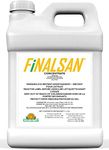Buying Guide for the Best Stump Killers
Choosing the right stump killer can make the process of removing unwanted tree stumps from your yard much easier and more effective. The best product for you will depend on the size and type of stump, how quickly you want results, and your comfort with handling chemicals or natural solutions. Understanding the key features of stump killers will help you select a product that matches your needs and ensures safe, efficient stump removal.Active IngredientThe active ingredient is the main chemical or natural compound that breaks down the wood in the stump. Common active ingredients include potassium nitrate, glyphosate, or natural enzymes. Potassium nitrate speeds up decomposition, making it easier to remove the stump, while glyphosate is a herbicide that kills the roots and prevents regrowth. Natural enzyme-based products are safer for the environment but may work more slowly. If you want fast results and don't mind using chemicals, potassium nitrate is a good choice. If you prefer a more eco-friendly approach and can wait longer, look for enzyme-based options.
Application MethodStump killers come in different forms such as granules, liquids, or powders, and each has a specific way to be applied. Granules and powders are usually poured into holes drilled in the stump, while liquids can be brushed or sprayed on the surface or into cuts. Granules and powders are often easier for deep penetration, while liquids can be more convenient for smaller stumps or surface treatment. Consider the size and accessibility of your stump when choosing the application method—larger, older stumps may benefit from granules, while smaller or freshly cut stumps might be fine with a liquid.
Speed of ActionThis refers to how quickly the stump killer works to break down the wood or kill the roots. Some products promise results in a few weeks, while others may take several months. Fast-acting chemicals are ideal if you want to remove the stump quickly, but they may be harsher on the surrounding environment. Slower-acting, natural products are gentler but require more patience. Think about your timeline—if you need the stump gone soon, opt for a faster-acting product; if time is not an issue, a slower, safer option may be better.
Safety and Environmental ImpactSafety and environmental impact refer to how the product affects people, pets, and the surrounding ecosystem. Chemical stump killers can be toxic if not handled properly and may harm nearby plants or contaminate soil and water. Natural or organic products are generally safer but may be less effective or slower. If you have children, pets, or a garden nearby, prioritize products with lower toxicity and clear safety instructions. Always follow the manufacturer's guidelines to minimize risks.
Residual EffectsResidual effects are the lasting impact the stump killer may have on the soil and surrounding area after use. Some chemicals can linger in the soil, affecting future plant growth or leaching into groundwater. Others break down quickly and leave little trace. If you plan to replant in the same spot or are concerned about long-term soil health, choose a product with minimal residual effects. Check the label for information on how long the product remains active in the soil.



















